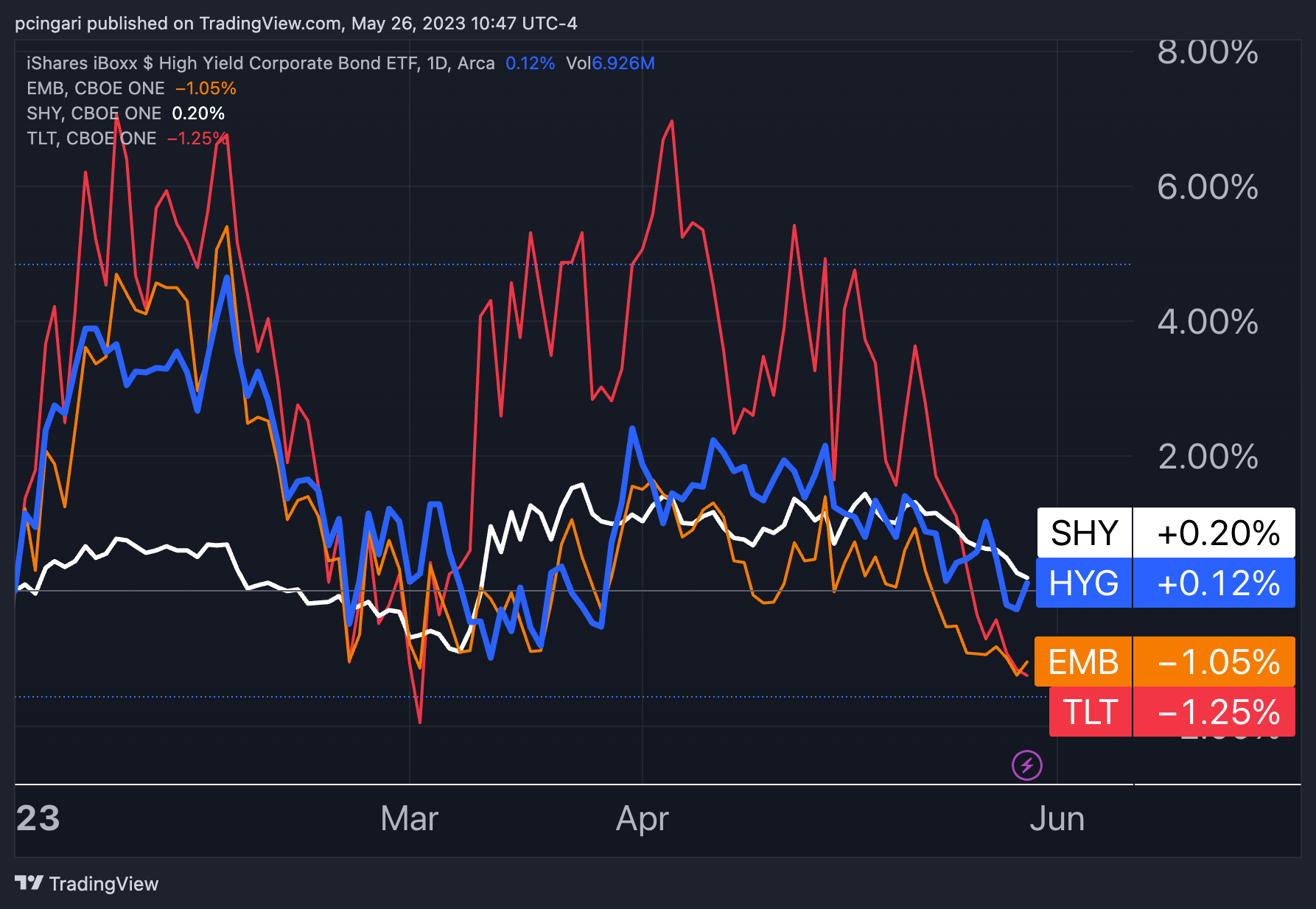Zinger Key Points
- Barely more than 100 hours separate the U.S. Treasury from running out of funds.
- Five bond ETFs could see substantial shifts depending on whether or not an agreement on the debt limit is reached.
- Markets are messy—but the right setups can still deliver triple-digit gains. Join Matt Maley live this Wednesday at 6 PM ET to see how he’s trading it.
The debt limit talk has reached its last and most important stage with just five days, or barely more than 100 hours, until the U.S. Treasury may run out of money.
Both the stock and the bond market are likely to react strongly depending whether a deal is reached or not, or if any other surprises arise at the end. Treasury yields could also see sharp swings on sensitive headlines in the coming hours.
Negotiators for the White House and the Republican Party are scrambling to avert a historic and probably catastrophic U.S. default, as Treasury Secretary Janet Yellen predicted "early June" as the date when the government's cash won't be able to meet all payments due.
The odds of an agreement being revealed late on Friday, May 26 or on Saturday, May 27, with a House vote the following week are the highest, according to Goldman Sachs Chief Economist Jan Hatzius.
Goldman Sachs' baseline forecasts see the U.S. Treasury reaching its minimal cash level on June 6, with funds totally depleted by June 9 if the debt limit is not raised.
Benzinga highlighted how these five bond ETFs could react to debt limit announcements in the coming hours.
1) IShares 0-3 Month Treasury Bond ETF SGOV
The fund managed by Blackrock Inc. BLK invests in Treasury bills with maturities up to three months. These are the shortest-dated U.S. Treasury securities which are particularly sensitive to the June deadline.
In the previous month, yields on one-month Treasury notes due after June have risen from 4% to 5.7%, indicating market worry regarding the debt limit resolution. Short-term T-bill rates will fall if the debt ceiling is lifted, raising the ETF's value.
2) IShares 1-3 Year Treasury Bond ETF SHY
The IShares 1-3 Year Treasury Bond ETF is particularly sensitive to market Fed rate expectations, which are substantially reflected in two-year Treasury yield fluctuations.
Short-term Treasury rates may fluctuate whether the debt ceiling is raised or not. A compromise will keep the Fed focused on recent inflation and labor market data, which have been hotter than expected, supporting market predictions for a June rate hike. ETFs will decrease if short-term rates rise, but yield-seeking investors may find an attractive entry point here if they think the Fed will soon end its tightening cycle.
Since a U.S. default would cause market disruptions and employment losses, the Fed would likely opt to stop raising interest rates in a no-deal situation. In this case, the value of the IShares 1-3 Year Treasury Bond ETF will rise.
3) IShares 20+ Year Treasury Bond ETF TLT
The IShares 1-3 Year Treasury Bond ETF is sensitive to long-term Treasury yield changes, which are heavily influenced by growth and inflation forecasts.
A deal is likely to increase in duration-exposed Treasury yields, to varying degrees depending on the amount of the expenditure reductions. Lower-than-expected budget cutbacks will provide a stronger push to yields than a debt limit agreement indicating substantial expenditure cuts.
4) iShares iBoxx $ High Yield Corporate Bond ETF HYG
HYG invests in high-yield corporate bonds denominated in U.S. dollars, which are by definition a risky asset that is closely tied to market sentiment.
If the debt limit resolution is seen positively by the market, high-yield corporates will profit from the wider risk-on atmosphere and the ETF's value is projected to rise.
A no-deal scenario or an agreement with significant budget cutbacks, on the other hand, may cause weakness in high-yield corporates, prompting investors to flee riskier assets and flock to safer alternatives.
5) iShares J.P. Morgan USD Emerging Market EMB
The fund invests in developing market dollar-denominated fixed-income instruments and may experience significant volatility depending on whether or not an agreement on the debt limit is reached.
Given that developing market bonds are a risky asset class, they tend to be linked to U.S. high-yield corporate bonds, so EMB could experience a similar impact as HYG. A broader risk-off mood could spark losses in EM bonds, while this market is likely to benefit from an increasing risk appetite.
Chart: Performance of SHY, TLT, EMB and HYG Year-To-Date

Photo: Shutterstock
Edge Rankings
Price Trend
© 2025 Benzinga.com. Benzinga does not provide investment advice. All rights reserved.
Trade confidently with insights and alerts from analyst ratings, free reports and breaking news that affects the stocks you care about.